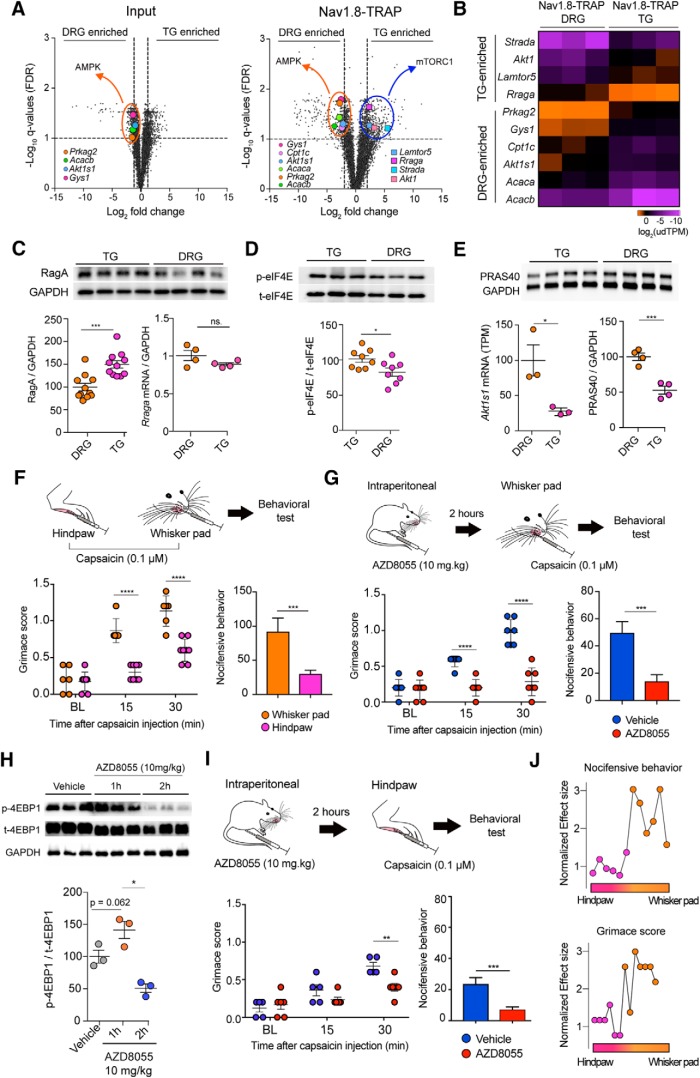Figure 6.
TRAP-seq analysis reveals that AMPK- and mTORC1-related genes are differential expressed and/or translated in the DRG and TG, respectively. A, Volcano plot showing an enrichment in AMPK-related genes in the input DRG sample, including Prkag2, Akt1s1, Gys1, Acacb, as well as in TRAP-seq (including Prkag2, Akt1s1, Gys1, Acacb, Acaca, and Cpt1c). In converse, mTORC1-related genes are enriched in TG, such as Strada, Rraga, Akt, and Lamtor5. B, Heatmap shows increase translation of AMPK and mTORC1 genes in the DRGs and TG, respectively. C, Immunoblotting shows an upregulation of RagA protein inTG (RagA: DRG = 100 ± 8.39,T = 149.8 ± 8.03, *p = 0.0003, n = 11), whereas Rraga mRNA measured by qRT-PCR was not different between DRGs and TG (Rraga: DRG = 1.120 ± 0.075, TG = 1.01 ± 0.024, p = 0.152, n = 4). D, Immunoblotting shows a lower level of eIF4E phosphorylation in the DRG compared with TG (p-eIF4E: TG = 100.5 ± 4.28, DRG = 79.98 ± 7.13, *p = 0.0404). E, The negative regulator of mTORC1, PRAS40 (Akt1s1) mRNA, and TE was significantly increased in DRGs and confirmed by an increase in protein level (Akt1s1: DRG = 100 ± 5.28, TG = 52.62 ± 5.48, ***p = 0.008, n = 4). F, Nocifensive behavior and grimace score after injection of capsaicin (0.1 μm) into the whisker pad or the hindpaw. Capsaicin induces a more intense affective response when injected into the whisker pad compared with the hindpaw as shown by the mouse grimace score at 15 and 30 min (two-way ANOVA: F(2,24) = 22.98, ****p < 0.0001, post hoc Sidak ****p < 0.0001 at 15 and 30 min). Likewise, nocifensive behavior is more pronounced when capsaicin was injected into the whisker pad compared with the hindpaw (F(1,12) = 11.62, **p < 0.0052, post hoc Sidak ***p = 0.002 at 60 min after capsaicin). G, Pretreatment with an mTORC1 inhibitor (AZD8055, 10 mg/kg) blocked capsaicin-induced nocifensive behavior in the whisker pad (F(2,24) = 13.93, ****p < 0.0001, post hoc Sidak ***p = 0.002 at 60 min after capsaicin) and affective pain (F(2,24) = 21.62, ****p < 0.0001, post hoc Sidak ****p < 0.0001 at 15 and 30 min). H, Intraperitoneal injection of AZD8055 (10 mg/kg) decreased the level of p-4EBP1 at 2 h (one-way ANOVA: F(2,6) = 19.15, **p = 0.0025, post hoc Dunnett: Veh vs 2 h, *p = 0.027) in the TG. I, AZD8055 inhibited capsaicin-induced grimace at 30 min (F(2,27) = 4.52, *p = 0.02, post hoc Sidak **p = 0.0034) and nocifensive behavior (F(1,9) = 17.45, **p < 0.0024, post hoc Sidak ***p < 0.001 at 60 min after capsaicin) when injected into the hindpaw. J, For each group of animals, the difference between the vehicle- and AZD8055-treated values was calculated and plotted for the nocifensive behavior and mouse grimace score. We observed a significantly larger effect size of AZD8055 in nocifensive behavior (unpaired t test, t = 3.52, df = 11, **p = 0.0048) and grimacing (unpaired t test, t = 5.54, df = 11, ***p = 0.0002) when capsaicin was injected in the whisker pad. ns, not significant.

